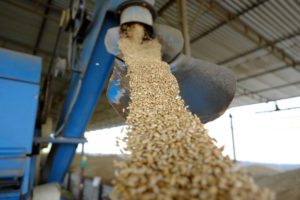
Ukraine for the ten months of the 2018/2019 marketing year (MY, September-August) exported 403,000 tonnes of sugar, which is 20% less than during the same period of the previous MY, the press service of the Ukrtsukor National Association of Sugar Producers has said. “It is likely that, according to the results of the current marketing year, sugar exports will amount to about 500,000 tonnes. This is 10% less than in the previous MY. The decline in supplies is due to low world sugar prices and an unfavorable market situation,” Ruslana Butylo, the deputy chairman of the association, said.
According to the association, sugar exports in June 2019 decreased by 40% compared with May and amounted to 24,800 tonnes.
“Azerbaijan remained the main importer of Ukrainian sugar in June, but Libya competed with it: these two countries accounted for 28% of total exports. Also, significant deliveries were made to Georgia and Tajikistan (12% and 10% respectively),” the expert said.

On Tuesday, July 9, at 10.00, the press center of the Interfax-Ukraine news agency will host a press conference entitled “Results of Exports of Fresh Fruits and Berries in 2018-2019. Forecast for Harvest (and Ukrainian Exports) for 2019-2020 Season.”
Participants: Dmytro Kroshka, the chairman of the Ukrainian Association of Agrarian Export, Volodymyr Hurzhiy, an expert for exports at First Ukrainian Apples Producers Aggregating Company USPA FRUIT, Oleksandr Yaschenko, the deputy director for research of the Institute of Horticulture, and Oleh Bosy, the agricultural technologist and managing partner of FruiTech (8/5a Reitarska Street). Registration of journalists requires press accreditation.
AGRARIAN, BERRIES, EXPORT, EXPORTS, FORECAST, FRUITS, HARVEST, PRESS CONFERENCE, RESULTS
Ukraine’s foreign trade in goods (exports), jan–apr, 2019

Ukraine in January-May 2019 increased electricity exports by 2.3% (by 60 million kWh) compared to the same period in 2018, to 2.713 billion kWh, the Ministry of Energy and Coal Industry has told Interfax-Ukraine. Electricity supplies from the Burshtyn TPP Energy Island in the direction of Hungary, Slovakia and Romania increased by 9.6% (by 161.2 million kWh), to 1.847 billion kWh.
Electricity supplies to Poland decreased by 15.2% (by 99.9 million kWh), to 556.6 million kWh.
Electricity supplies to Moldova amounted to 309.5 million kWh, which is 0.4% (1.2 million kWh) less than in January-May 2018.
For the five months of 2018 and 2019, Ukrainian electricity was not exported to Belarus and Russia.
In addition, in the first five months of this year, Ukraine imported 11.8 million kWh of electricity from the Russian Federation and Belarus compared to 14.8 million kWh in January-May 2018.

Ukraine since the beginning of the 2018/2019 marketing year (MY, July-June) and as of June 21, 2019 had exported 48.902 million tonnes of grain and leguminous plants, which is 26.3% more than on the same date of the previous MY.
According to the Ministry of Agrarian Policy and Food, farmers exported 29.2 million tonnes of corn, 15.5 million tonnes of wheat, and 3.5 million tonnes of barley.
They also exported 289,600 tonnes of flour on the indicated date.
As reported, with reference to the ministry, Ukraine exported 39.4 million tonnes of grain in the 2017/2018 MY.

Ukraine could increase grain exports to China in the 2019/2020 marketing year (MY, July-June), Olena Neroba, the adviser to the president of the Ukrainian Grain Association (UGA), has said at a press conference. According to her, China this year has experienced a significant reduction in the number of pigs due to ASF, and since substitution of pork with imports is quite expensive and time consuming, China is likely to compensate for the deficiency of protein in poultry. This factor and the trade war with the United States will lead to an increase in demand for barley and other grains, which Ukraine can take advantage of, Neroba said. If earlier practically the only importer of Ukrainian barley was Saudi Arabia, then the opening of a new market will allow increasing the volume of exports of this crop and raising the price.
She also noted that Ukraine this season has felt some U.S. influence on the Egyptian market, which is one of the main consumers of Ukrainian corn. According to the expert, although the absolute figures of exports to Egypt increased slightly compared to last year, however, the share of Egypt in in the structure of Ukrainian grain exports declined.